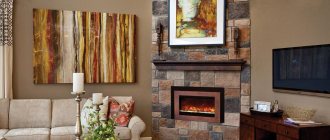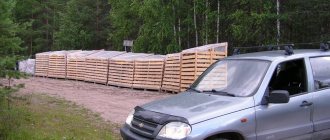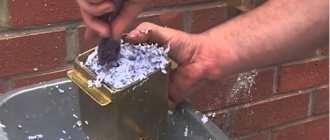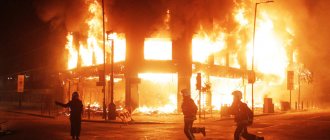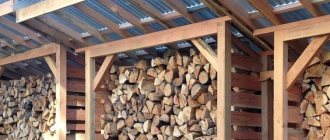Soot layering
When fuel burns, soot is formed. Over the years, it accumulates, which leads to a narrowing of the pipe diameter. Already a pipe - worse traction. Therefore, you need to clean the chimney regularly. This simple procedure not only increases draft, but also increases the effect of the stove.
Special briquettes are provided to clean the chimney from soot.
They eat away soot, soot, creosote and tar. They contain virtually no moisture or non-combustible impurities. Combustion products leave the pipe with a stream of hot air.
How do you dry firewood? To heat the stove with dry wood.
Wet and damp are better than raw, of course. But dry wood is exactly the type of firewood that needs to be used to heat the stove... Otherwise, it is difficult to achieve the effect that anyone who has experience living with a stove that heats well is used to.
Firstly, you need to protect the firewood, which seems to have dried out from direct precipitation. This will still reduce the possible moisture content of the firewood in inclement weather. When firewood is stacked in several layers, moisture flowing inside the stacks can remain there for a long time. It will increase the moisture content of the wood long after the rain.
Ideally, this is a special firewood shed covered with good roofing material, or at least a firewood shed tightly put together with boards.
Secondly, in order for wet firewood to effectively evaporate moisture, it is necessary to cut it... otherwise it will take a long time to dry.
Thirdly: in order for the firewood to dry completely, it must lie for two seasons, protected from precipitation - in the wind. Therefore, ideally, in a household with stove heating, there should be a supply of firewood for 2-3 years in advance - so that the firewood has time to dry thoroughly.
Well, the most interesting thing is that wet firewood from the street (and in any case, the firewood on the street will be wet, although not damp) needs to be brought into the house so that it becomes really dry. The firewood is drying out indoors. The relative humidity of dry firewood is considered to be from 8 to 15%. This is the best firewood for heating a stove.
It’s best to store a supply of firewood in the room for 2-5-7 days so that it has time to dry, then the burning process will be easy.
Now let's talk about heating the stove with wood.
Air pressure
The condition of the chimney is also affected by the climate outside the bathhouse. If the temperature outside drops, there is a decrease in traction. Cold air sinks down and exerts pressure. Often, a clogged pipe and cold air work together to create a “clog.”
This problem can be solved in two steps: 1) cleaning the chimney with a briquette; 2) its insulation. Basalt wool, ceramic fiber-based material and fire-resistant boards are suitable as insulation. Ready-made cylindrical insulation materials are also available for sale.
Processes that occur when wood is burned
Either way, if all goes well, we will get to the moisture evaporation stage of the wood burning process, where instead of generating heat, heat is absorbed as the water trapped inside the wood turns into steam and is removed from the wood by evaporation. Most often, the observant pyromaniacs among us noticed this phenomenon occurring at the smaller ends of the branches, where the water just below the bark evaporated and flowed into the hearth.
Technically, this first stage of wood burning relies on the wood reaching 100 degrees Celsius as the water in the wood begins to boil and then evaporates.
As we explained in our Guide to Efficient Pool Heating, evaporation takes a lot of energy - which goes against the grain of burning wood for heat, the first rule of burning wood in stoves or fireplaces: dry wood. The maximum moisture content should be considered in the range of 15-20%, so when choosing firewood, consider the moisture content as well as the type of wood.
Unlike moisture in damp or unseasoned logs, volatile gases are flammable. They burn and produce heat. Thus, when the surface temperature of wood rises above 100 °C to approximately 230 °C,
gases rich in creosote are released: carbon dioxide, carbon monoxide, acetic and formic acids. However, since these gases produced in the first stage of combustion do not ignite until all the moisture has evaporated and the kindling temperature is hot enough to ignite them, this results in increased emissions levels. We've said it before - the first rule of wood burning? Dry firewood!
Once this process of evaporation of excess moisture is completed and the temperature in our stove or fireplace rises, this leads to the second stage of wood combustion.
Metal visor
As planned, the canopy should be useful - it protects the pipe from precipitation. But often this protective barrier brings only problems. In a confined space, smoke escape is difficult. Traction worsens due to an artificial air plug.
There are two ways to deal with this problem:
1) complete refusal of the visor;
2) moving the visor higher from the pipe.
An alternative to the classic visor is nozzles with exhaust deflectors or weather vanes-deflectors.
If you have glass smoking near the stove door...
In any oven there are times when glass smokes. This often happens during kindling, when the stove is still cold or the air lock has not been “broken.” The combustion temperature is not yet high, and there is a lot, a lot of unburnt gases, smoke, which does not have time to escape and can swirl around the glass of the door.
Glass blowing measures do not always help, although we try to make fireboxes with glass ventilation. It may be trivial to have damp firewood (among other things).
What to do in such a situation?
Just try for the first 15-30 minutes of the fire, while the wood is burning, open the fire door 0.5-1 centimeter, this is enough to cut off the smoke from the glass. This will also provide additional oxygen for lighting the stove. With this calculation, you can open the blower a little less.
Depressurization
Depressurization occurs both in old baths and in new ones - if serious mistakes were made during the installation of the pipe. The chimney loses its tightness due to cracks, shifts and other damage.
To seal the pipe, high-temperature sealants or so-called are used. polymer stockings.
The tightness of the chimney is a guarantee of safety. If this condition is not met, the risk of fire increases significantly, since sparks or ash can get into the holes.
Source
Ways to increase the efficiency of a metal furnace
Currently, craftsmen use different options for increasing power when creating furnaces. New schemes and designs of structures are used.
Let's look at several effective and simple options that can increase the amount of heat generated without additional fuel costs.
In order to increase the efficiency of a metal furnace, there are several common methods:
- The first step for a stove without a convector casing is to install side screens. To do this, you need to purchase sheets of metal and attach them to the stove body using bolts or self-tapping screws. The thickness of the iron is not important since iron is a good conductor of heat. Such screens should be located at a distance of 5-6 cm from the metal stove.
Thanks to this design, the principle of heat distribution and transfer completely changes. Now the thermal energy generated by the furnace will be transferred through convection, and not through radiation, as happened previously. In the gap between the stove and the iron, warm air will form and circulate heat in the room. Thanks to this technique, the rate of heating the room increases significantly, and there is also a noticeable saving in fuel resources.
- One of the simple and effective ways to increase heat in the house is also to install a metal hood above the stove. Thus, the heat will rise upward and go into the hood, and then, using a pipe, it will be supplied to the far corner of the room. Due to this, the zone in which the least heat enters will be heated faster and the room will be heated much faster. Thanks to this simple invention, heat will not escape through the ceiling above the stove.
- The third option that increases the efficiency of a metal stove is to change the design of the stove chimney. The chimney is an integral and necessary part of the heating system of the stove. It is during this period that many problems arise with the normal functioning of the furnace, and significant heat loss also occurs. In the standard version of a metal stove, the pipe is straight, and the smoke masses, entering such a structure, immediately go outside. In order to increase heat transfer to a traditional pipe, you can add a pair of elbows. For example, you can create a pair of 90-degree bends and make the pipe format in the shape of the English letter S. The smoke will pass more slowly, the pipe will heat up, which will provide additional heat transfer.
Why does the stove smoke in the bathhouse?
The construction of a sauna stove is relatively simple. The design includes 4 functional elements:
If there is no draft in the bathhouse, the cause is any violation in the operation or structure of the structural elements, with the exception of the heater.
Errors in the design of the furnace leading to smoke
If, at the first attempt to light the stove in the bathhouse, smoke comes out, this indicates design errors. It is recommended to immediately contact a specialist:
Important!
If smoke does not appear in the bathhouse immediately, but after several years of operation, this does not indicate a design error, but a malfunction or exhaustion of the resource.
Pipe length
The height of the chimney in the bathhouse matters. It must rise above the ridge of the building, otherwise the draft will not be enough for normal operation of the furnace. The smoke exhaust structure is protected with a metal cap. If it is not there, strong winds can easily penetrate inside and prevent smoke from being removed.
Another design error is the location of the smoke exhaust duct at the same level as the combustion chamber door or even below it. In this case, normal draft is not enough to prevent the smoke from returning.
The best option is a straight pipe. Deviation from the vertical is allowed, but weakens traction. Turns and angles increase the risk of clogging.
Insufficient chimney cross-section
The dimensions of the stove in the bathhouse depend on the size of the heated room. This parameter determines not only the dimensions of the combustion chamber, but also, accordingly, the diameter of the chimney. These device parameters are of decisive importance:
Important!
The best option for a stove in a bathhouse is a steel chimney. However, this option must be thermally insulated, and not only when passing through the ceiling, but along the entire length.
How to heat a stove with raw wood
Wet wood burns worse and more slowly, but it can also be lit by following the specified operating procedure.
Lighting a stove with raw wood is somewhat different from the usual procedure:
- Prepare the oven as usual.
- Take small twigs and arrange them in a herringbone pattern. Provide air access - there should be a distance between the rods. If there are no twigs or brushwood, you can make them from bark. Peel the log, turn the bark into strips.
- Light the stove. Close the shutter, the view should be open.
- After some time, the rods will flare up and you can add damp firewood, leaving a distance between them. To speed up burning, you can add paper. Thin wood chips create heat, which helps moisture in the wood evaporate faster.
- It takes about 15 minutes for the carbon monoxide to dissipate. After this, you can open the damper and door.
- Place firewood in small portions for better burning.
It is highly undesirable to use kerosene, gasoline or other flammable liquids. They will only contribute to excess smoke from damp wood. Wet firewood will burn more slowly and to properly warm up the stove you will need 2-3 times more wood than regular firewood.
You need to monitor the draft level by the color of the flame. The flame is bright white and there is a hum in the oven? We urgently need to reduce cravings.
If the smoke is black and the flame is red, the draft, on the contrary, needs to be increased.
The normal color of the flame is golden yellow, the combustion is even, without crackling or smoke.
From fruit trees
The brushwood obtained from regular pruning of garden trees can also be used as firewood, especially if you “bundle” logs from it and light the stove in a cold house. If we consider specifically “fruit” firewood, which is better also depends on density, and in terms of this indicator, middle-aged apple and pear trees win. However, you can very rarely find them on sale and not in all regions, unless you have to uproot trees from your own garden. It is worth using such valuable firewood either for the fireplace, so that the house has a pleasant smell, or for the bathhouse for the same reasons, but it is more advisable to leave it for the smokehouse or barbecue.
Aspen
Aspen firewood is at the bottom of the rating both in terms of density and calorific value, but it burns without smoke, without soot, and without soot. On the contrary, they are used to clean the chimney, since the vapors released by wood during the combustion process can settle on the sooty walls and corrode soot deposits. If you use aspen for periodic burning, it will be much easier to maintain the chimney in working condition. It will not be possible to completely get rid of the need for periodic maintenance, but it is possible to reduce the number of approaches and labor costs. You can also light a stove with aspen splinters; they set quickly. When choosing what kind of firewood will be needed in large volumes, aspen is definitely not in the top. It is enough to prepare a dozen or two logs of it, but if the stove is not only in the house, but also in the bathhouse, and there is also a fireplace, the reserves should be increased.
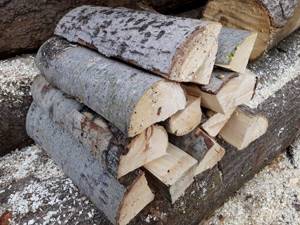
Poplar, willow
If fruit firewood is not widely used due to its rarity, heating with poplar or willow wood is simply not practical. They emit minimal heat and burn almost instantly; to warm up the stove, not to mention the house, you will need more than one load. Even taking into account the bargain price or the opportunity to collect poplar trunks for free, after the utility workers, when choosing what kind of firewood to burn, it is not worth considering. Only when there are absolutely no other options, you can “stand still” with such firewood for some short time until you can prepare or buy good ones.
Evaporation of hydrocarbon compounds
In the second stage of wood burning, we are still not in the heat production phase (perhaps just a little), but we are getting close! At the moment we are over 260 degrees and the temperature is rising. The chemical structure of the wood begins to break down and the process of pyrolysis begins. Pyrolysis “releases organic gases and leaves behind carbon. This process also creates a mixture of hydrocarbons in the form of droplets of liquid resin and flammable gases. At this point we have hydrocarbon vapors, carbon monoxide, methane, water vapor, carbon dioxide, and a good mixture of other vapors. This is a major turning point for the efficiency of a wood stove or fireplace as temperatures continue to rise.
Once the moisture is driven out of the wood and the temperature raises the temperature of the wood above 280°C, the second stage of combustion occurs. This is the heat production stage. This occurs at two different temperature levels: primary and secondary combustion.
Primary combustion:
The process by which gases are released from wood and burned is called primary combustion. Primary combustion begins at about 280 °C, continues up to 480 °C and releases a large amount of energy. Primary combustion also releases large amounts of unburned combustible gases, including methane and methanol, as well as more acid, water vapor, and carbon dioxide.
Secondary combustion:
These gases, called secondary gases, contain up to 60 percent of the potential heat in wood, so their efficient and optimized combustion is really important to achieve high overall combustion efficiency in a wood stove or fireplace. Secondary gases are not burned near wood due to lack of oxygen (oxygen is consumed during primary combustion) or due to insufficient temperature.
The conditions necessary for the combustion of secondary gases are a sufficient amount of oxygen and a temperature of at least 600 °C. Air supply is a critical element in the combustion process—which is why high-efficiency fireplace or wood stove maintenance is just as important as air. Too little air will not support secondary combustion of the gas and too much will cool the temperature to the point where this secondary combustion cannot occur.
Remember that air is about 80 percent inert gas and when supplied to a wood stove is well below the 600°C required to support secondary combustion. The more air is mixed with secondary gases, the more heat is absorbed by nitrogen and the lower the temperature of the secondary gas-air mixture.
Secondary combustion can and does occur in high-efficiency wood stoves and fireplaces that are designed to meet or exceed EPA clean air requirements, but only if the stove is used with properly dried and seasoned wood, operated according to its design and connected to a properly functioning chimney. .
Many people don't realize that the chimney is the engine that powers the stove (or fireplace), and that if the chimney is the wrong size, not tall enough, then the draft will be inadequate and a beautiful fireplace will be a disappointment at best, and in the worst - even dangerous.
Incomplete combustion is wasteful and stops the process from producing carbon monoxide, which is suboptimal, especially if the chimney does not extract enough and may be returning CO into the house.
Ignition and combustion of gas vapors - the effect of “afterburning” of secondary combustion
Now that we have all these flammable gases in place to maximize wood burning efficiency and minimize pollution, they now need to reach and maintain a minimum threshold temperature to burn the gas vapors.
Burning wood - what needs to be burned well
In this combustion cycle, carbon is the first to react with oxygen to form the potentially deadly carbon monoxide, although interestingly, more than half of the heat generated by combustion at this point comes from the combustion of hydrocarbon gases and carbon monoxide itself. For combustion to continue, the temperature must usually remain above 600 degrees, but can reach 1000 degrees! Ironically, at this stage of combustion, friend water is also produced as hydrogen and oxygen molecules combine with the large amount of water vapor contained in the flue gases. It is therefore important that the possibility of flue gas condensation is minimized and that chimney materials are corrosion resistant and corrosion resistant for a long service life.
Burning Charcoal - A cozy warm glow from the coals - perfect for fire watching!
This is the last stage of combustion, as the first three processes left the carbon in the charcoal as the only combustible material remaining. To keep it burning, temperatures above 500 degrees are needed to burn this carbon-rich coal, but it can burn with little or no flame. When you hear the sound and warmth of embers burning at the tail end of a fire, it is actually the coal being burned in charcoal, which is the basis for the smelting and production of traditional steel!
Let's summarize the stages of combustion; The process of burning wood is complex as different woods are at different stages when a fire burns, the bottom line is that by choosing the right wood you need to precisely control the combustion temperature and oxygen levels to optimize the combustion process.
